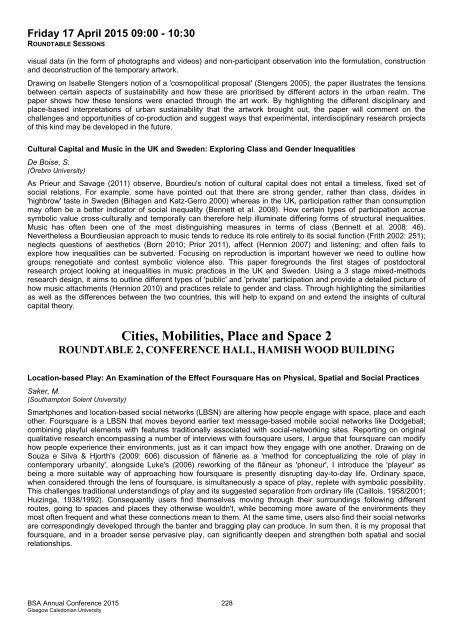Programme full
Programme full
Programme full
You also want an ePaper? Increase the reach of your titles
YUMPU automatically turns print PDFs into web optimized ePapers that Google loves.
Friday 17 April 2015 09:00 - 10:30<br />
ROUNDTABLE SESSIONS<br />
visual data (in the form of photographs and videos) and non-participant observation into the formulation, construction<br />
and deconstruction of the temporary artwork.<br />
Drawing on Isabelle Stengers notion of a 'cosmopolitical proposal' (Stengers 2005), the paper illustrates the tensions<br />
between certain aspects of sustainability and how these are prioritised by different actors in the urban realm. The<br />
paper shows how these tensions were enacted through the art work. By highlighting the different disciplinary and<br />
place-based interpretations of urban sustainability that the artwork brought out, the paper will comment on the<br />
challenges and opportunities of co-production and suggest ways that experimental, interdisciplinary research projects<br />
of this kind may be developed in the future.<br />
Cultural Capital and Music in the UK and Sweden: Exploring Class and Gender Inequalities<br />
De Boise, S.<br />
(Örebro University)<br />
As Prieur and Savage (2011) observe, Bourdieu's notion of cultural capital does not entail a timeless, fixed set of<br />
social relations. For example, some have pointed out that there are strong gender, rather than class, divides in<br />
'highbrow' taste in Sweden (Bihagen and Katz-Gerro 2000) whereas in the UK, participation rather than consumption<br />
may often be a better indicator of social inequality (Bennett et al. 2008). How certain types of participation accrue<br />
symbolic value cross-culturally and temporally can therefore help illuminate differing forms of structural inequalities.<br />
Music has often been one of the most distinguishing measures in terms of class (Bennett et al. 2008: 46).<br />
Nevertheless a Bourdieusian approach to music tends to reduce its role entirely to its social function (Frith 2002: 251);<br />
neglects questions of aesthetics (Born 2010; Prior 2011), affect (Hennion 2007) and listening; and often fails to<br />
explore how inequalities can be subverted. Focusing on reproduction is important however we need to outline how<br />
groups renegotiate and contest symbolic violence also. This paper foregrounds the first stages of postdoctoral<br />
research project looking at inequalities in music practices in the UK and Sweden. Using a 3 stage mixed-methods<br />
research design, it aims to outline different types of 'public' and 'private' participation and provide a detailed picture of<br />
how music attachments (Hennion 2010) and practices relate to gender and class. Through highlighting the similarities<br />
as well as the differences between the two countries, this will help to expand on and extend the insights of cultural<br />
capital theory.<br />
Cities, Mobilities, Place and Space 2<br />
ROUNDTABLE 2, CONFERENCE HALL, HAMISH WOOD BUILDING<br />
Location-based Play: An Examination of the Effect Foursquare Has on Physical, Spatial and Social Practices<br />
Saker, M.<br />
(Southampton Solent University)<br />
Smartphones and location-based social networks (LBSN) are altering how people engage with space, place and each<br />
other. Foursquare is a LBSN that moves beyond earlier text message-based mobile social networks like Dodgeball;<br />
combining playful elements with features traditionally associated with social-networking sites. Reporting on original<br />
qualitative research encompassing a number of interviews with foursquare users, I argue that foursquare can modify<br />
how people experience their environments, just as it can impact how they engage with one another. Drawing on de<br />
Souza e Silva & Hjorth's (2009: 606) discussion of flânerie as a 'method for conceptualizing the role of play in<br />
contemporary urbanity', alongside Luke's (2006) reworking of the flâneur as 'phoneur', I introduce the 'playeur' as<br />
being a more suitable way of approaching how foursquare is presently disrupting day-to-day life. Ordinary space,<br />
when considered through the lens of foursquare, is simultaneously a space of play, replete with symbolic possibility.<br />
This challenges traditional understandings of play and its suggested separation from ordinary life (Caillois, 1958/2001;<br />
Huizinga, 1938/1992). Consequently users find themselves moving through their surroundings following different<br />
routes, going to spaces and places they otherwise wouldn't, while becoming more aware of the environments they<br />
most often frequent and what these connections mean to them. At the same time, users also find their social networks<br />
are correspondingly developed through the banter and bragging play can produce. In sum then, it is my proposal that<br />
foursquare, and in a broader sense pervasive play, can significantly deepen and strengthen both spatial and social<br />
relationships.<br />
BSA Annual Conference 2015 228<br />
Glasgow Caledonian University


